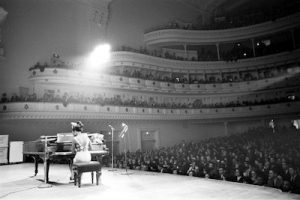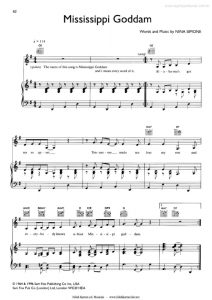
Nina Simone’s upbringing in classical piano clearly influenced the music she created and performed, since she frequently liked referring to her unfulfilled goal as a musician to become “the first black classical concert pianist” (Simone 45). For example, Simone herself writes about Johann Sebastian Bach’s influence over her early introduction to: “Once I understood Bach’s music I never wanted to be anything other than a concert pianist” (Simone 23). Considering her background in classical study, I will analyze both “Pirate Jenny” and “Mississippi Goddam” using classical conventions in an attempt to understand how Simone “classicalized” the songs on In Concert, complicating her perceived identity as simply a jazz singer. By manipulating classical conventions such as periodicity, harmony, and melody, Nina Simone musically expresses her anger while simultaneously stirring negative and fearful sentiments from her primarily white audience at Carnegie Hall. Using these basic conventions, I will analyze how Nina Simone signifies her music by manipulating these concepts of classical style (typically regarded as white and male dominated) to subvert her audience’s expectations of black women musicianship.
When specifically analyzing the classical convention of periodicity in the song “Pirate Jenny,” it is clear that this song employs periodicity to move toward the overarching goal of expressing the emotion of anger through its structure. In the book Classic Music: Expression, Form and Style, music scholar Leonard G. Ratner defines periodicity as “the tendency of classical music to move toward goals, toward points of punctuation” (33). Simone was well aware of the importance of periodicity in regard to classical music, specifically noting that, “When you play Bach’s music you have to understand that he is a mathematician and all the notes you play add up to something – they make sense” (Simone 23). Simone’s piano technique during her performance of “Pirate Jenny,” just like the compositions of her baroque-era idol, manipulates periodicity to create a sense of anticipation and suspense. Each verse of the song acts as a self-contained expression, or period, that accumulates over the course of the whole song and are separated by dramatic silences when all instruments cut out. Likewise, the piano playing during these verses are quick staccato jabs, centering on and always returning to an a flat major chord until the end of each period. This quick, almost frantic piano part grows louder with each verse, underscoring the hauntingly tense story Simone relates to her audience.
This is an image of Nina Simone performing in 1965 on the Carnegie Hall stage. Again, I recognize that this is not the exact 1964 performance that I discuss in my argument. However, I believe this source is important because it shows Nina performing in the same space and with a similar audience. This image in particular portrays the classical atmosphere that helped to produce the music of In Concert.
Classical musical conventions not only appear on “Pirate Jenny” but also on the last song on the live album “Mississippi Goddam”. For the purposes of my argument, I will explain how the classical elements of harmony and melody both influence “Mississippi Goddam” because of the song’s classical sense for key. The book Classic Music: Expression, Form and Style defines harmony as essential to classical music since it “governs the form of an entire movement through the classic sense for key” (Ratner 48). Similarly, melody offers the framework for delineating the basic harmony and rhythm of the classical piece, built upon “first with simple coherent materials, upon which various degrees of elaboration are incorporated for eloquence” (Ratner 81-82). In reference to “Mississippi Goddam,” the piano harmony accompanies and highlights the melody sung by Nina Simone during each chorus on the lyrics “everybody knows about Mississippi Goddam,” which ends on the g major chord. G major is the key of the chorus “a” section of the song (since the song follows the typical aaba structure of a showtune), thus the melody during the chorus delineates and elaborates within this key. The melody and piano harmony of the chorus progress chromatically from the note a on “everybody” up until the note d on “Mississippi,” a point of suspense for the audience which yearns to be resolved on the tonic g sung on “Goddam,” the most climactic moment of the chorus. This climactic moment is also the most direct expression of anger, suggesting that the classical conventions on this song, like the intentional suspension of harmony and melody, all work to stir negative and fearful sentiments from Nina Simone’s white audience at Carnegie Hall. By “classicalizing” her performance of anti-racist music through piano conventions inspired by Bach’s baroque-era compositions, Nina Simone resists her unfair categorization as simply a “jazz singer”.
This is the sheet music of Nina Simone’s 1964 performance of “Mississippi Goddam.” As indicated in my musical analysis, this song incorporates the classical piano conventions of harmony and melody as a way to progress toward the musical expression of anger.
I would also like to also draw an appropriate comparison between Nina Simone’s “classicalization” of black popular music and the Duke Ellington orchestra’s first Carnegie Hall performance in 1943. Duke Ellington, the renowned jazz and big-band composer, manipulated classical appearance in Carnegie Hall in order for his work to be considered “serious” art. At this performance specifically, Ellington would premiere the ambitious work Black, Brown and Beige, thus he felt the need to reflect the aesthetic properties of classical music in order to be considered as a more “serious” musician. As scholar Harvey J. Cohen elaborates on this historic performance, “By focusing on the subject of black history for his heavily promoted inaugural Carnegie Hall performance and dressing like a classical conductor, Ellington provided a strong counter to the way black Americans were usually portrayed in the mass media” (1004). In other words, by relying on classical formalities in a similar way to how Simone incorporates them into her performance, Ellington sought to cultivate “an image of respectability and ‘genius’ in his music” (Cohen 1004). 21 years, later, Nina Simone’s performances in Carnegie Hall would rely on a manipulation of classical ideas because she too wanted to be taken more seriously than just a “jazz singer,” a title she believed to be unfair and demeaning.

(Cover photo of this page: This is a picture of Nina Simone playing and singing at her piano in Carnegie Hall, 1964. This is the best image I could find of one of Simone’s actual performances on this legendary stage.)


